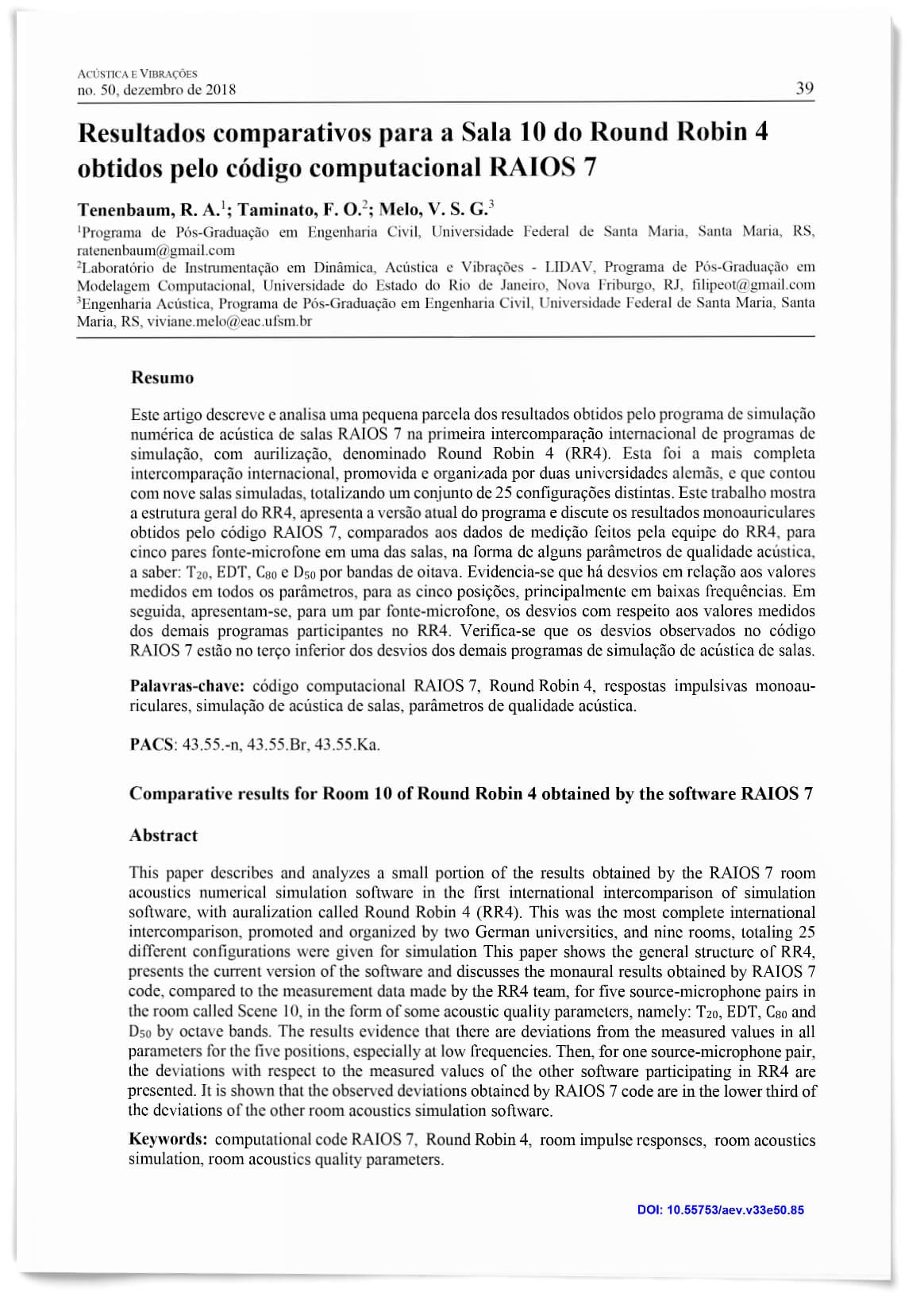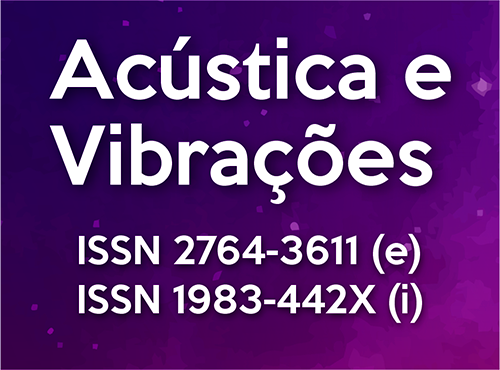Comparative results for Room 10 of Round Robin 4 obtained by the software RAIOS 7
DOI:
https://doi.org/10.55753/aev.v33e50.85Keywords:
computational code RAIOS 7, Round Robin 4, room impulse responses, room acoustics simulation, room acoustics quality parametersAbstract
This paper describes and analyzes a small portion of the results obtained by the RAIOS 7 room acoustics numerical simulation software in the first international intercomparison of simulation software, with auralization called Round Robin 4 (RR4). This was the most complete international intercomparison, promoted and organized by two German universities, and nine rooms, totaling 25 different configurations were given for simulation This paper shows the general structure of RR4, presents the current version of the software and discusses the monaural results obtained by RAIOS 7 code, compared to the measurement data made by the RR4 team, for five source-microphone pairs in the room called Scene 10, in the form of some acoustic quality parameters, namely: T20, EDT, C80 and D50 by octave bands. The results evidence that there are deviations from the measured values in all parameters for the five positions, especially at low frequencies. Then, for one source-microphone pair, the deviations with respect to the measured values of the other software participating in RR4 are presented. It is shown that the observed deviations obtained by RAIOS 7 code are in the lower third of the deviations of the other room acoustics simulation software.
References
VORLÄNDER, M. Auralization: Fundamentals of Acoustics, Modelling, Simulation, Algorithms and Acoustic Virtual Reality. Berlin: Springer-Verlag, 2008. doi: 10.1121/1.2908264 DOI: https://doi.org/10.1121/1.2908264
KLEINER, M.; DALENBÄCK, B.I.; SVESSON, P. Auralization - an overview. J. audio Eng. Soc, 41, p. 861, 1993.
BLAUERT, J. Spatial Hearing. Cambridge: The MIT Press, 1997. doi: 10.7551/mitpress/6391.001.0001 DOI: https://doi.org/10.7551/mitpress/6391.001.0001
RINDEL, J. The use computer modeling in room acoustics. Journal of Vibroengeneering, 4(3):41–72, 2000.
TENENBAUM, R.A.; CAMILO, T.S.; TORRES, J.C.B. and GERGES, S.Y. Hybrid method for numerical simulation of room acoustic: Part 1 – theorical and numerical aspects. J. Braz. Soc. Mech. Sci. Engin., 29(2):211–221, 2007a. doi: 10.1590/S1678-58782007000200012 DOI: https://doi.org/10.1590/S1678-58782007000200012
BORK, I. Report on the 3rd Round Robin on room acoustical computer simulation - Part II: Calculations. Acta Acustica united with Acustica, 91(4):753–763, 2005.
SAVIOJA, L.; SVENSSON, U.P. Overview of geometrical room acoustic modeling techniques. J. Acoust. Soc. Am, 138(2):708–730, 2015 doi: 10.1121/1.4926438 DOI: https://doi.org/10.1121/1.4926438
EMBRECHTS, J. Randomly traced sound ray techniques. Acustica, 51:285–295, 1982.
KULOWSKI, A. Algorithmic representation of the ray tracing technique. Applied Acoustics, 18:449–469, 1984. doi: 10.1016/0003-682X(85)90024-6 DOI: https://doi.org/10.1016/0003-682X(85)90024-6
ONDET, M; BARBRY, J.L. Modeling of sound propagation in fitted workshops using ray tracing. J. Acoust. Soc. Am., 85(2):787–796, 1989. doi: 10.1121/1.397551 DOI: https://doi.org/10.1121/1.397551
FARINA, A. RAMSETE – a new pyramid tracer for medium and large-scale acoustic problems. Proceedings of the Euronoise, Lyon, 1995
ALLEN, J.B.; BERKLEY, D.A. Image method for efficiently simulating small-room acoustics. J. Acoust. Soc. Am., 65, p. 943, 1979. doi: 10.1121/1.382599 DOI: https://doi.org/10.1121/1.382599
DALENBÄCK, B; KLEINER, M.; SVENSON, P. A macroscopic view of diffuse reflection. J. audio Eng. Soc. 42:793–807, 1994. http://www.aes.org/e-lib/browse.cfm?elib=6927
KURZINS, E.; FRICKE, F. The prediction of sound fields in non-diffuse spaces by random walk approach. J. Sound and Vib., 81(4):549–564, 1982. doi: 10.1016/0022-460X(82)90296-6 DOI: https://doi.org/10.1016/0022-460X(82)90296-6
ALARCÃO, D.; BENTO COELHO, J.L.; TENENBAUM, R.A. On modeling of room acoustics by a sound energy transition approach. Proceedings of EEA Symposium on Architectural Acoustics, 2000.
GARDNER, B.; MARTIN, K. HRTF Measurements of a KEMAR Dummy-Head Microphone. J. Acoust. Soc. Am., vol. 97, n. 6, pp. 3907– 3908, 1995. https://citeseerx.ist.psu.edu/viewdoc/summary?doi=10.1.1.39.9751 DOI: https://doi.org/10.1121/1.412407
BRINKMANN, F.; LINDAU, A.; WEINZIERL, S.; VAN DER PAR, S.; OPDAM, R.; VORLÄNDER, M. The FABIAN head-related transfer function database. doi: 10.14279/depositonce-5718.2, 2017.
MILLS, A. On the minimum audible angle. J. Acoust. Soc. Am., 30:237–246, 1958. doi: 10.1121/1.1909553 DOI: https://doi.org/10.1121/1.1909553
KISTLER, D. J.; WIGHTMAN, F.L. A model of head-related transfer functions based on principal components analysis and minimum-phase reconstruction. J. Acoust. Soc. Am. 91(3), 1637–1647, 1992. doi: 10.1121/1.402444 DOI: https://doi.org/10.1121/1.402444
TORRES, J.C.B; PETRAGLIA, M.R.; TENENBAUM, R.A. An efficient wavelet based HRTF model for auralization. Acta Acustica united with Acustica, 90(1):108−120, 2004.
HU, H.; ZHOU, L.; MA, H.; WU, Z. HRTF personalization based on artificial neural network in individual virtual auditory space. Applied Acoustics, 69(2):163–172, 2008. doi: 10.1016/j.apacoust.2007.05.007 DOI: https://doi.org/10.1016/j.apacoust.2007.05.007
TENENBAUM, R.A.; TAMINATO, F.O.; MELO, V.S.G.; TORRES, J.C.B. Auralization generated by modeling HRIRs with artificial neural networks and its validation using articulation tests. Applied Acoustics, 130, pp. 260–269, 2018. doi: 10.1016/j.apacoust.2017.09.025 DOI: https://doi.org/10.1016/j.apacoust.2017.09.025
BROOMHEAD, D.; LOWE, D. Multivariable functional interpolation and adaptive networks. Complex Systems, 2:321–355, 1988.
LI, L.; HUANG, Q. HRTF personalization modeling based on RBF neural network. Proceedings of IEEE International Conference on Acoustics, Speech and Signal Processing, p. 3707–3710, Vancouver, Canada, 2013. doi: 10.1109/ICASSP.2013.6638350 DOI: https://doi.org/10.1109/ICASSP.2013.6638350
TENENBAUM, R.A.; CAMILO, T.S.; TORRES, J.C.B. and STUTZ, L.T. Hybrid method for numerical simulation of room acoustic: Part 2 – validation of the computational code RAIOS 3. J. Braz. Soc. Mech. Sci. Engin., 29(2):223–231, 2007b. doi: 10.1590/S1678-58782007000200013 DOI: https://doi.org/10.1590/S1678-58782007000200013
FERNANDES, K.M.; TENENBAUM, R.A.; STUTZ, L.T. Problema inverso em propagação de ondas em sólidos com aplicação de método híbrido de otimização. Em: Técnicas de Inteligência Computacional com Aplicações em Problemas Inversos de Engenharia. Editora Omnipax, Curitiba, pp. 51–66, 2014. DOI: https://doi.org/10.7436/2014.tica.05
RAHIM, M.G., GOODYEAR, C.C. and KLEIJN, W.B. On the use of neural networks in articulatory speech synthesis. J. Acoust. Soc. Am., v. 93(2):1109–1121, 1992. doi: 10.1121/1.405559 DOI: https://doi.org/10.1121/1.405559
HAYKIN, S. Neural Networks and Learning Machines. 3rd Edition, Prentice Hall, New Jersey, 2009.
TAMINATO, F.O. Redes neurais artificiais aplicadas à modelagem de respostas impulsivas associadas à cabeça humana para gerar aurilização. Tese de doutorado, Programa de Pós-graduação em Modelagem Computacional, Universidade do Estado do Rio de Janeiro, 2018. http://www.bdtd.uerj.br/handle/1/13714
TENENBAUM, R.A.; TAMINATO, F.O.; MELO V.S.G. Fast auralization using radial basis functions type of artificial neural network techniques. Applied Acoustics, 157, 106993, 2020. doi: 10.1016/j.apacoust.2019.07.041 DOI: https://doi.org/10.1016/j.apacoust.2019.07.041
A Ground Truth for Room Acoustic Simulation. doi: 10.14279/depositonce-6726.2, outubro 2019.
HODGSON, M.; YORK, N.; YANG, W.; BLISS, M. Comparison of predicted, measured, and auralized sound fields with respect to speech intelligibility in classrooms using CATT-acoustic and ODEON. Acta Acustica united with Acustica, 94(6):883–890, 2008. DOI: https://doi.org/10.3813/AAA.918106
MELO, V.S.G.; TENENBAUM, R.A.; NARANJO, J.F.L. A new approach to validate computer modeling auralizations by using articulation indexes. Acústica & Vibrações, Vol. 46, pp. 1−8, 2014.
POLLOW, M.; BEHLER, G. Variable directivity for platonic sound sources based on spherical harmonics optimization. Acta Acustica united with Acustica, 95(6):1082–1092, 2009. DOI: https://doi.org/10.3813/AAA.918240
KLEIN, J.; POLLOW, M.; VORLÄNDER, M. Optimized spherical sound source for auralization with arbitrary source directivity. Proceedings of the EAA Joint Symposium on Auralization and Ambisonics, p. 56–61, Berlin, 2014. doi: 10.14279/depositonce-10
LINDAU, A.; ERBES, V.; LEPA, S.; MAEMPEL, H.J.; BRINKMANN, F.; WEINZIERL, S. A spatial audio quality inventory for virtual acoustic environments (SAQI). Acta Acustica united with Acustica, 100(5):984–994, 2014. DOI: https://doi.org/10.3813/AAA.918778
MELO, V.S.G.; LIMA, P.G.; SANTOS, T.C.; TENENBAUM, R.A. Validação de realidade virtual acústica via testes de articulação em salas ruidosas e reverberantes. Acústica & Vibrações, 49, pp. 51–57, 2017. DOI: https://doi.org/10.55753/aev.v32e49.95

Downloads
Published
How to Cite
Issue
Section
License
Copyright (c) 2018 Acústica e Vibrações

This work is licensed under a Creative Commons Attribution-NonCommercial-ShareAlike 4.0 International License.




